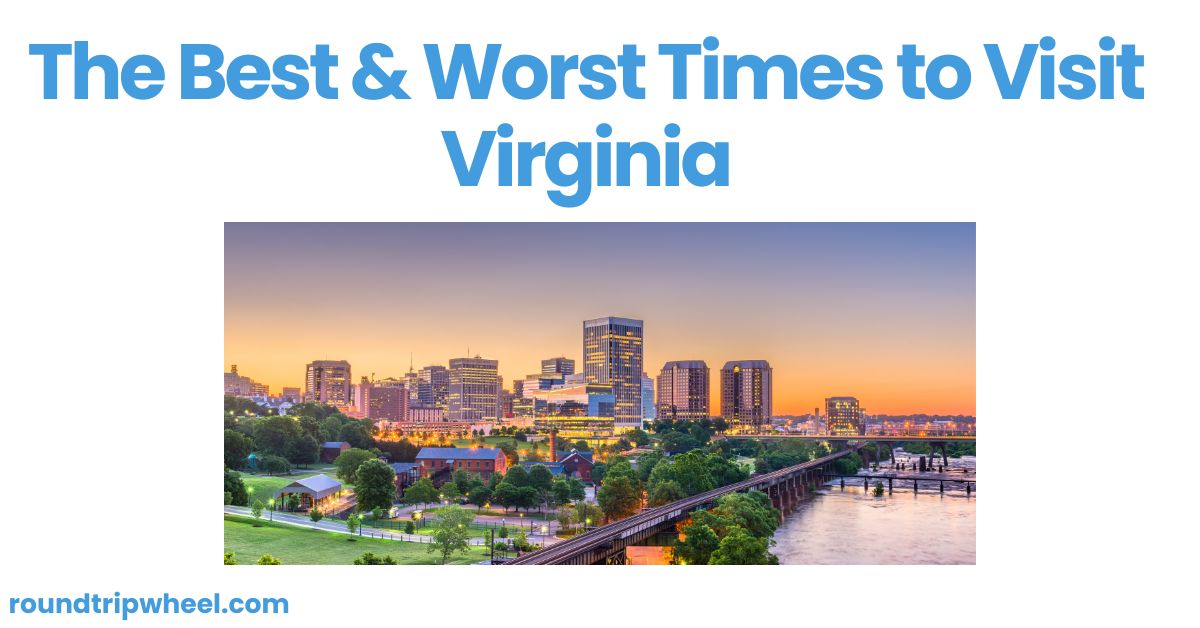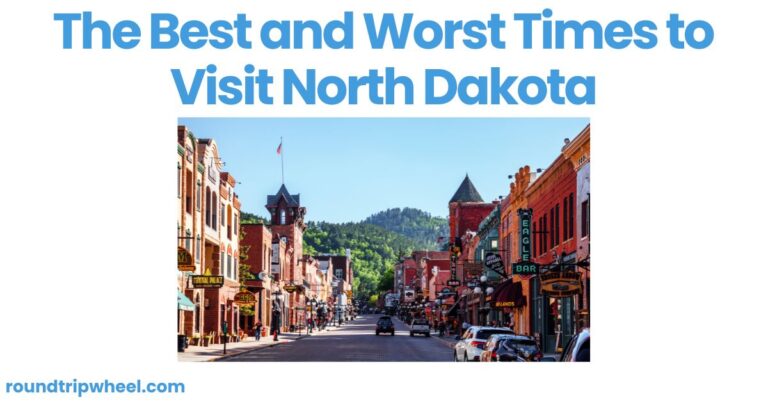The Best & Worst Times to Visit Virginia

Virginia, the Mother of States, is a captivating destination that offers something for every traveler, from rich history and vibrant cities to stunning natural landscapes and coastal retreats. However, the timing of your visit can significantly impact your overall experience. In this comprehensive guide, we’ll explore the best and worst times to visit Virginia, taking into account factors such as weather, crowds, events, and activities.
The Best Times to Visit Virginia
Spring (March to May)
Spring in Virginia is a delightful time to visit, as the state awakens from its winter slumber with a burst of color and renewal. The mild temperatures, ranging from the mid-50s to the mid-70s, provide ideal conditions for exploring the great outdoors.
One of the highlights of visiting Virginia in spring is the opportunity to witness the stunning display of blooming flowers. From the iconic cherry blossoms in Washington D.C. to the vibrant azaleas and dogwoods that adorn the streets and gardens throughout the state, spring in Virginia is a true feast for the senses.
This season is also an excellent time for outdoor activities such as hiking, biking, and exploring the state’s numerous parks and natural areas. The Shenandoah National Park, with its picturesque Blue Ridge Mountains and cascading waterfalls, is particularly stunning during this time of year.
Spring is also a popular time for festivals and events in Virginia. The Virginia International PAN Fest in May celebrates Caribbean culture through music, dance, and cuisine, while the East Coast She Crab Soup Classic in April is a must-visit for seafood lovers.
Fall (September to November)
Fall in Virginia is a truly magical time, as the state transforms into a vibrant tapestry of warm hues, from fiery reds and oranges to golden yellows. The crisp, cool temperatures, ranging from the mid-60s to the mid-70s, create perfect conditions for outdoor adventures and cozy evenings by the fire.
One of the biggest draws of visiting Virginia in the fall is the opportunity to witness the spectacular fall foliage. The Blue Ridge Mountains, Shenandoah Valley, and Skyline Drive offer breathtaking vistas of changing leaves, making them popular destinations for leaf-peeping and scenic drives.
Fall is also an excellent time for festivals and events in Virginia. The Virginia Beach Craft Beer Festival in October celebrates the state’s thriving craft beer scene, while the Richmond Folk Festival in October showcases diverse cultural traditions through music, dance, and crafts.
Additionally, fall is a prime time for outdoor activities such as hiking, apple picking, and vineyard tours. The state’s many wineries offer a cozy and romantic setting for wine tastings and vineyard visits, while the apple orchards invite visitors to pick their own fresh fruit and indulge in apple-based treats.
The Worst Times to Visit Virginia
Summer (June to August)
While summer may be a popular time for vacations, it can be a challenging season to visit Virginia, especially for those who are sensitive to heat and humidity.
During the summer months, temperatures in Virginia can soar into the 80s and 90s, with high humidity levels that can make outdoor activities quite uncomfortable. The coastal regions, such as Virginia Beach and the Chesapeake Bay area, can be particularly muggy and warm during this time.
Additionally, summer is peak tourist season in Virginia, which means that popular destinations, beaches, and attractions can be incredibly crowded and expensive. Hotel rates, flight costs, and attraction prices tend to be at their highest during these months.
While summer has its advantages, such as beach days and outdoor concerts, the combination of high temperatures, humidity, and crowds can make it a less desirable time to visit for some travelers.
Winter (December to February)
Winter in Virginia can be a mixed bag, with both advantages and drawbacks for visitors. While the state experiences fewer crowds and lower prices during this season, the weather can be unpredictable and often quite cold.
Temperatures in Virginia during the winter months typically range from the mid-30s to the mid-50s, with the potential for snowfall, particularly in the mountainous regions. While the snow can create a picturesque winter wonderland, it can also lead to travel disruptions and limited access to certain outdoor attractions and activities.
Additionally, many outdoor attractions and activities may be closed or have reduced hours during the winter months, limiting the options for visitors. However, this can be an excellent time to explore Virginia’s vibrant cities, such as Richmond and Alexandria, with their rich history, museums, and indoor attractions.
Winter can also be an excellent time for those seeking a cozy and romantic getaway, with opportunities to enjoy Virginia’s wineries, cozy inns, and fireside dining experiences.
Factors to Consider When Planning Your Visit
Weather
Virginia’s weather can be unpredictable and varied, depending on the region and time of year. While spring and fall offer milder temperatures and beautiful scenery, summer can be hot and humid, especially in the coastal areas. Winter can bring snow and cold temperatures, particularly in the mountain regions.
It’s essential to research the specific weather patterns of the area you plan to visit and pack accordingly. Layering clothing and being prepared for sudden weather changes can help ensure a comfortable and enjoyable trip.
Crowds and Prices
Popular tourist destinations in Virginia, such as Virginia Beach, Colonial Williamsburg, and Shenandoah National Park, can become extremely crowded during peak seasons, such as summer and holidays. This can lead to longer wait times, limited availability, and higher prices for accommodations, attractions, and activities.
If you prefer fewer crowds and lower prices, consider visiting Virginia during shoulder seasons or off-peak times. Not only will you find more affordable options, but you’ll also have a more relaxed and intimate experience at the attractions and destinations.
Events and Festivals
Virginia is home to a diverse array of festivals and events throughout the year, celebrating everything from music and art to food and cultural traditions. These events can be a wonderful way to immerse yourself in the local culture and traditions, but they can also contribute to increased crowds and higher prices in the area.
If you plan to attend a specific event or festival, be sure to book your accommodations and make any necessary reservations well in advance to ensure availability and secure the best rates.
Outdoor Activities
Virginia offers a wealth of outdoor activities, from hiking and camping in the Blue Ridge Mountains to kayaking and fishing in the Chesapeake Bay. The best time to engage in these activities will depend on the specific activity and your personal preferences.
For example, fall is an excellent time for hiking and leaf-peeping, while spring and summer are ideal for water sports and outdoor concerts. Winter can be a great time for skiing and snowshoeing in the mountain regions.
Consider your interests and the specific activities you hope to enjoy during your visit to Virginia, and plan your trip accordingly.
Conclusion
Determining the best time to visit Virginia ultimately depends on your personal preferences, interests, and priorities. Spring and fall offer mild weather, stunning scenery, and a variety of festivals and events, making them ideal times for many visitors. Summer can be a popular but crowded and hot time to visit, while winter offers fewer crowds and lower prices but can be cold and unpredictable.
By considering factors such as weather, crowds, prices, events, and outdoor activities, you can plan the perfect trip to Virginia and make the most of your visit to this vibrant and diverse state. Whether you’re seeking a relaxing beach getaway, an immersive cultural experience, or an outdoor adventure, Virginia has something to offer throughout the year.

About Author
Hey there, fellow explorers! I’m Mark Rodriguez, a big fan of adventures and always hungry for more. Packed with stories and a trusty camera, I’m on a mission to explore cool places around the world.
I love diving into new cultures and landscapes. As a travel writer, my goal is to get you excited about stepping out of your comfort zone, trying new things, and discovering the awesome magic our world has.
Check out my blog for cool stories, travel ideas, and helpful tips to plan your own amazing getaway!






